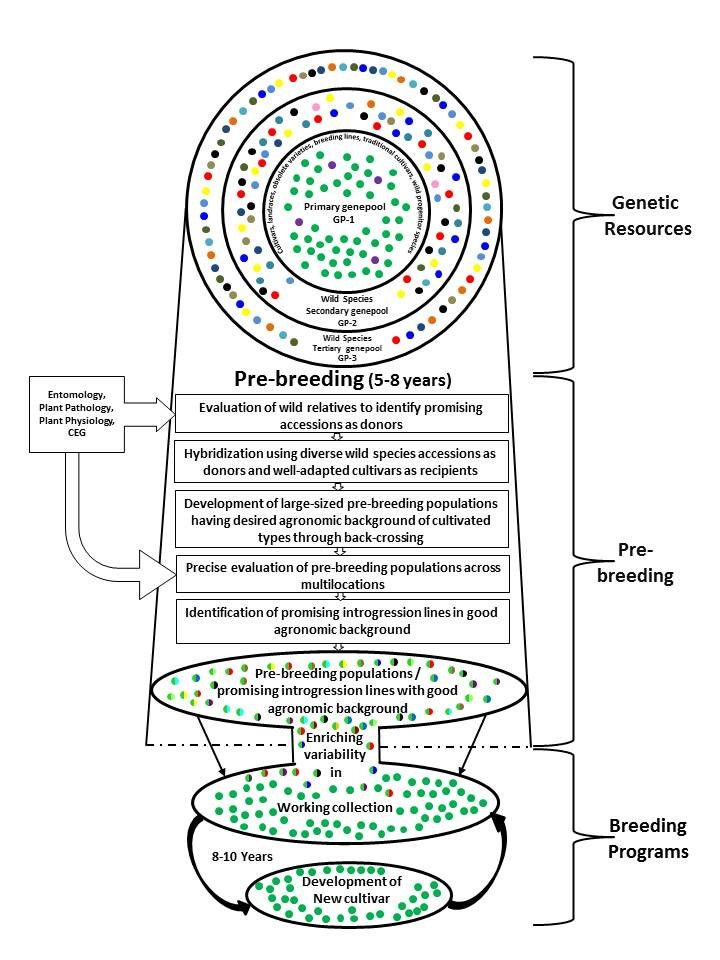Authors: Kuldeep Tripathi and Padmavati G. Gore
The narrow genetic base of agriculture today is apparent a threat to food security. modern agriculture practices becomes the serious threat to our rich biodiversity, as the genetically uniform modern varieties are replacing the highly diverse local cultivars and landraces in traditional agro-ecosystems, resulted in increased genetic vulnerability of the cultivars for pests and diseases. In addition to this changing climate also demands for the search for new genes/traits for better adaptation. Thus, increased genetic uniformity, evolving pest and pathogen populations, climate change and increased demand for food and nutrition necessitates the identification and utilization of diverse germplasm sources to develop new high-yielding cultivars with a broad genetic base. This factor also motivates the plant breeders to look for new sources of desirable genes in genebanks. Genebank is the storehouse for the genetic diversity. Wild relatives with enhanced levels of resistance/tolerance to multiple stresses provide important sources of genetic variation for crop improvement. However, their exploitation for cultivar improvement is limited by cross-incompatibility barriers and linkage drags. Pre-breeding provides a unique opportunity, through the introgression of desirable genes from wild germplasm into widely adopted genetic backgrounds. Now question comes what is plant breeding and what are the strategies to perform it?
What is Pre breeding?
Pre breeding is the identification of desirable traits and/or genes from unadapted materials that cannot be used directly in breeding populations, and to transfer these traits to an intermediate set of materials that breeders can use further in producing new varieties for farmers. Pre breeding is essential for linking genetic diversity arising from wild relatives and other unimproved materials to utilization. It is the main link between the germplasm conservation and its use in plant breeding. These activities are a collaboration between the germplasm curator and the plant breeder who need to work germplasm collections and how new traits from these collections can be bred into new varieties. Pre-breeding activities using promising landraces, wild relatives, and popular cultivars have been initiated. The use of molecular markers is greatly assisting in reducing linkage drags and increasing the efficiency of introgression in pre-breeding programs.
The pre-breeding increased access to, and use of, genetic variations conserved in genebanks which directly facilitates the efficiency and effectiveness of crop improvement programmes.
The decision to do pre-breeding is based on the expected efficiency and efficacy of ultimately moving the target traits into cultivars for farmers and source of desired gene(s).
Pre-breeding is become necessary, when desired genes are available only in:
• Genebank accessions those are not well-adapted to the target environment
• Closely related wild species that are easily crossed with the crop species
• More distant wild species which are more difficult to cross
Applications of pre-breeding in crop improvement:
Pre breeding mainly applied in four major aspects:
1) Narrow genetic base results into the crop vulnerability to different biotic and abiotic stress. Pre breeding is adopted for broadening the genetic base, to reduce vulnerability.
2) Identifying desirable traits in exotic materials and moving those genes into material more readily accessed by breeders.
3) Wild species and crop wild relatives are the reservoir of the gene for cope with the changing climate, identification of this important gene and moving them from wild species into breeding populations when this appears to be the most effective strategy.
4) Identification of novel genes in the unrelated species and transfer them using genetic transformation techniques.
Challenges in adopting pre-breeding:
Though pre breeding is the playing key role in crop improvement, there are several factors which become obstacles in adopting pre breeding as the first step of crop improvement.
1) Lack of characterization and evaluation data-with lack/ false data of accession it is not possible to use this accession in the pre breeding.
2) Knowledge of the genetic diversity- to use the accessions in the pre breeding extensive knowledge about genetic diversity of individual and population is essential.
3) Inter species relationship-cross incompatibility is the major factors which limits the use of different species in transferring gene of importance across the species.
4) Strong breeding program and funding sources.
5) Linkage drag-The use of genebank accessions in breeding programmes is limited by the high degree of difficulty and length of time often associated with separating the desirable genes from the undesirable ones.

Figure- procedure of pre breeding and breeding programs.
About Author / Additional Info:
Currently working as scientist in ICAR-NBPGR.